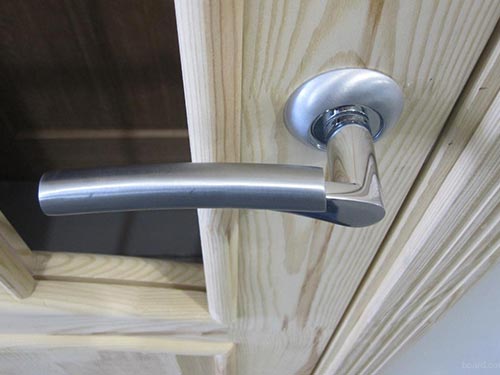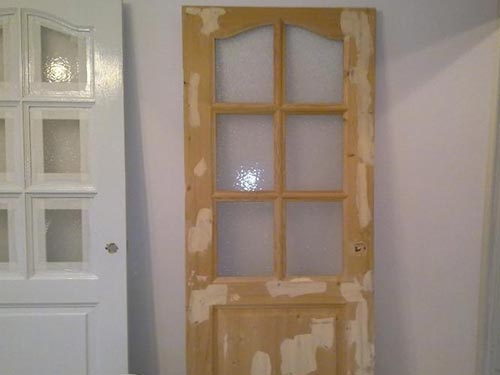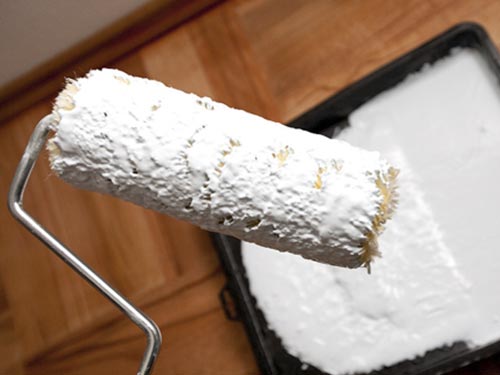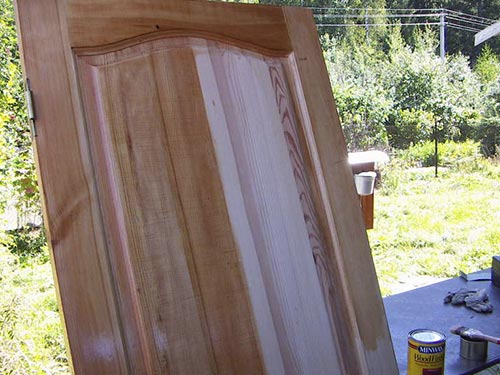In the photo, painting a wooden door with your own hands
With prolonged use, door leaves and frames lose their attractiveness as a result of wear or the expiration of the decorative coating.
Do-it-yourself painting of a wooden door will allow you to save money and acquire the skills of installation and finishing work.
You can also show your creative ideas and perform original painting with visual highlighting of individual parts of the structure.
Types of paints
Currently, there is a huge selection of paints for painting wood. They are qualitatively divided into transparent and opaque. The first option is used if it is necessary to preserve the natural color of the wood and the visibility of the fiber structure. These include stains and impregnations that protect wood from insects and fungi.
Note!
They can give a slight tonality to the natural color, making the appearance more presentable.
The second option - opaque paint is more in demand, because it allows you to achieve maximum compliance with the interior design of the room. These can be enamels and compositions based on acrylic, polyurethane, alkyds and oils.
What paint to choose?
For interior work, acrylic enamels are most often used. They allow you to get the optimal viscosity for ease of use with a brush: it spreads well, forming a thin uniform layer and is able to maintain color vibrancy throughout the entire service life. It does not have a pungent odor and therefore even allergy sufferers can dye. Paint for exterior doors is selected based on the temperature characteristics of the climate, air humidity and rainfall. In such cases, alkyd paint is simply irreplaceable, as it increases resistance to temperature extremes, moisture and sunlight. Coloring is able to dry much faster than other compounds. However, when working with it, personal respiratory protection should be used because it is toxic.

Hardware needs to be removed before painting.
Preparatory work
Before painting, it is advisable to remove the door from the hinges and place it on a horizontal stable surface. It is advisable to lay it with paper or oilcloth so that dirt and dust do not get on the canvas. Then, using an industrial hair dryer with a wide nozzle, they rip off the old paint to wood. The old paint is heated with a hot stream of air until it swells, after which it is easily combed off. In hard-to-reach places, the nozzle is removed and the area is heated, after which the paint layer is removed with a knife or a small spatula. At the end of the work, polishing is carried out with emery or sandpaper.
Remove the door or not?
It is convenient to paint the doors in the removed position, since the paint does not drip, no streaks form, there is access to all cracks and inconvenient places. It is possible to assess the condition of the canvas more objectively and, if necessary, replace the problematic parts. In addition, there will be no pungent smell of solvent, coloring composition and varnish in the room. The time spent on dismantling is fully justified, since financial resources are saved for painting doors that are obviously unusable, and it will also be possible to carry out work in any convenient place. However, if the canvas is new, and painting is carried out only in order to change the color shade, then you can paint it right on the spot, having previously fixed the open position of the door.

Irregularities need to be patched
We close up small defects in the canvas
Before painting a wooden door, it is necessary to hide possible defects, such as cracks, chips and places, pest infestations. Putty is taken and applied to problem areas with a spatula in small quantities. Then it is carefully leveled. After drying, grinding is carried out with a "zero". The surface is cleaned with a dry soft cloth to remove dust, and then washed. It should be noted that only small defects can be hidden in this way. In case of rotten areas or serious cracks, it is recommended to make a suitable part from a similar type of wood and replace it.
What primer to use?
The tree must be primed without fail to improve water resistance, increase adhesion, especially of dense wood species, impregnate the outer layer to reduce paint costs. Before painting an old wooden door with opaque paint, alkyd primers and alkyd-based compounds diluted with water are applied.
Note!
The color of the primer should differ from the main color by a tone or semitone towards the light side, so as not to affect the outer coating.
Under the transparent layer, oil- and water-based primers are used, which have disinfectant, insecticidal and antifungal agents. By color and type, they should have a great affinity with the decorative coating.

Performing a single color painting
The easiest option is to paint the canvas and the box in the same color. The brush must be fluffed before use in order to remove excess hairs and give softness. After that, painting is carried out in three stages. At the first stage, the ends of the door are covered with a layer of paint, starting from the upper corners and ending with the lower, longitudinal movements of the brush. At the second stage, the plane of the canvas is painted from left to right. Then the paint must dry in accordance with the instructions for use. After drying, a second coat of paint is applied in the longitudinal direction from top to bottom. If the paint is partially absorbed, then a third layer can be applied to obtain a rich color.
Application of several tones
For interiors with complex decor elements, it may be necessary to apply several layers of different colors. They take adhesive tape and seal the entire surface, which should not be covered by the main color. After drying, glue the painted parts and apply paint to the remaining places. It is not enough to paint the front door to the children's room in several colors and you have to create complex drawings. First, stencils are made, with an adhesive composition applied on the reverse side. Staining is carried out in the main color, and when the paint dries, a stencil is installed and painted in additional tones. The disadvantage of this method is the appearance of the color of the substrate to the outside. Therefore, such patterns are selected so that the background is lighter, and subsequent layers are darker.

Performing simulated wood fibers
This option is non-standard for painting wooden canvases, since they have a natural pattern, but it is the simplest implementation of a complex pattern for do-it-yourself work. The sequence of work is as follows:
- The canvas is painted completely yellow by the method of monophonic painting in one or two layers.
- With a brush, liquid soap is evenly applied to all surfaces.
- A layer of dark paint is applied, imitating wood fibers.
- Soap is washed off.
Conclusion
Before painting an interior wooden door, it is necessary to determine the operating conditions, requirements for surface quality and color. But before that, the front of the canvas and the box should be processed accordingly. This will guarantee the successful completion of the work and significantly increase the life of the door.
